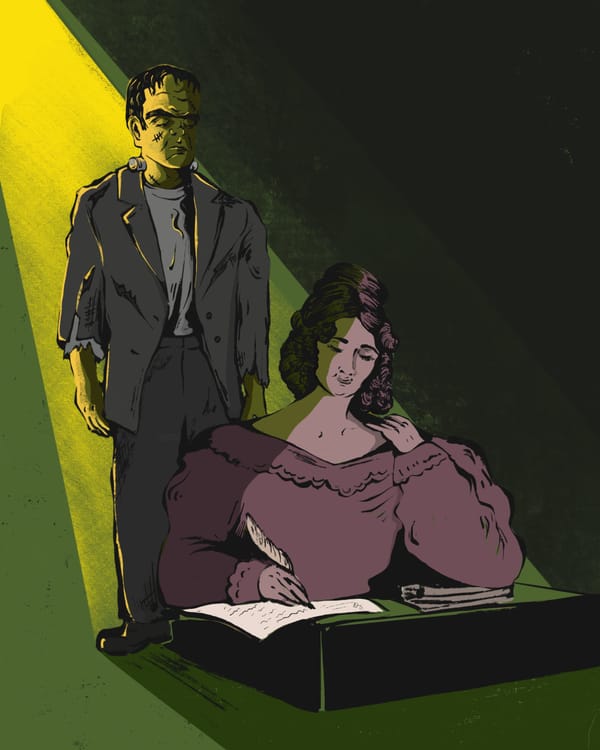‘I Couldn’t Stay Away’
A reenactment of the Dominique Pelicot trial takes on a life of its own, becoming as real as the trial itself.

This past weekend, I found myself in Avignon again—a city in southeastern France known for its Gothic architecture and its medieval bridge (yes, the one from the song). It is also where the historic rape trial of 72-year-old Dominique Pelicot—and the 50 men who had been filmed sexually abusing his unconscious wife, Gisèle—took place last year.
I wrote about the case for this publication and am working on a book about it. The appeal trial for the one man who contested the court’s decision is scheduled to be held in October; I will attend that, too. With Gisèle having been awarded the Legion of Honor earlier this month and her book set for publication in January, these events are hardly in the rearview mirror.
And yet, the Swiss theater director Milo Rau, who has a reputation for addressing controversial subjects, and the French playwright Servane Dècle have teamed up to present a staged reenactment of the trial at the annual Avignon Festival. But…so soon?
I was curious to see how they would interpret the months-long trial for the stage. The production—”The Pelicot Trial”—which had debuted in Vienna in June, would be performed once in Avignon, and would then go on the road.
Familiar and different
In what felt like a scene from “Groundhog Day,” I took the same train from Paris, used the same taxi service from the station, and stayed in the same part of town that I always had.
The show, held in a 14th-Century convent just outside the walls of the Palace of the Popes, was set to start at 10 p.m. on Friday night and run a cool four hours. (I’ll let you do the math.) The venue could hold 500 people and tickets were in high demand. I knew Gisèle and her lawyers didn’t plan to attend. Why would they? They had already lived through the grueling months of testimony. But I couldn’t stay away. I wanted to see how others perceived the trial, how the creators would present it.
Everything was familiar. And everything was different.
Inside the courtroom, we had watched videos of men penetrating Gisèle’s inert body and listened to them explain why their actions did not, in their view, constitute rape. But even outside the courthouse, as we exited at the end of each demoralizing day and wandered into nearby restaurants or made our way back to hotel rooms, we still couldn’t escape. The rapes felt omnipresent, part of the fabric of the place. The taint hovered over the city like a toxic smog.
This past weekend was different. The city’s walls were once again plastered over, but this time, with colorful posters inviting the festival’s 30,000 visitors to come see one of the 200-plus shows on offer at the Avignon Festival. The streets were clogged with clusters of friends and families. Café tables lined sidewalks and filled squares, nearly every seat occupied. Music filled the air.
At one point, I passed by the café where we journalists had gathered last December on the night before the verdicts were handed down, sharing a final meal before we dispersed. Had its name not been written in giant letters, I might not have clocked that it was the same place, so changed was the surrounding ambiance.
Setting the scene

As I approached the performance space for “The Pelicot Trial,” there was the same group of feminist activists—the Amazons of Avignon—who had turned up at the courthouse to support Gisèle every day during the trial. They were standing side-by-side, holding up a long white banner on which they had painted “No Closed-Door Sessions.” It was a reference to Gisèle’s insistence that her trial be open to the public.
Despite their visibility during the trial, the Amazons hadn’t been consulted when Rau and Dècle were researching and developing the work, nor had they been asked to collaborate, as other key players had been. They hadn’t even been invited to attend. They were, once again, on the outside, just as they had been during the trial. And just as they had then, they chanted slogans, sang feminist hymns, and detonated colored smoke bombs.
It all felt very meta.
(When I suggested as much to Rau during an interview the next day, he was delighted. “That’s cool!” he said, then, in jest: “Actually, we were paying them.”) (For the record, they were not.)
As I made my way in, I bumped into journalists I had met during the trial. Many now wore summer tans, and all looked more relaxed and better rested than they had in December. Putting the trial behind them had done them visible good. We filtered into the convent’s central courtyard to take our seats under the open sky. Already 9:30 p.m., the sky was growing dark.

The stage was a replica of the courtroom: There was a desk in the center representing the “bar”—the equivalent of a witness stand—flanked on either side by rows of plain pine benches; they looked exactly like the benches where journalists, defense lawyers, and the accused men had sat during the trial, only now they were occupied by the actors playing us. Sitting in front of large pillars on each side were two of the court artists who had sketched daily during the Pelicot trial. They were sketching again, except instead of Dominique Pelicot and his accomplices, they were drawing the actors.

The performance begins
A man wearing a black suit and turquoise bead necklace, walked onto the stage. A countertenor, he sang the Cold Song from Purcell’s “King Arthur.” Although the words, were incomprehensible to me, the libretto goes something like this:
What power art thou?
Who from below
Hast made me rise?
Unwillingly and slow
From beds of everlasting snow!
Then, a white-haired woman in a floral dress rose from one of the benches and walked toward him. She didn’t look like Gisèle but one could say she was Gisèle-esque. I would later learn that she was the Oscar-nominated French actress, Marie-Christine Barrault.
Barrault read from the Italian poet Petrarch’s description of his 1336 ascent of Mont Ventoux; most of Gisèle’s rapists lived in the villages surrounding the base of that mountain. I didn’t need to know who Barrault was to know the performance was extraordinary. But still, it was a performance.

Rendition and fact began to meld when the actor, Teresa Coutinho, began reading from the book that Gisèle’s daughter, Caroline Darian, had published in 2022 after learning what her father had done. The text was in the first person, and it described the house where the rapes had taken place. By the time the actress Ariane Ascaride took the stage to incarnate Gisèle, just over an hour into the performance, I had become fully immersed in this alternate reality. I felt Gisèle’s anger, her pain, her sense of betrayal. We were back in the courtroom.
Only a lone bat that swept in from time to time, flying circles over the heads of the actors, pulled me occasionally back to the present. In one such moment, I scanned the other spectators: They were mostly women, but still, there were far more men here than there had been in the public audience at the trial. In another interlude of bat distraction—there were two flying gracefully in tandem this time—I looked up and noticed the leering gargoyles jutting out, monstrous, from the walls that formed our perimeter. “Rape is a terrible democracy: Anyone can be a victim,” an actor was saying.
Tick tock
As the clock ticked on, the production started to take on a life of its own, becoming as real as the trial itself. Authentic, but different. The actors embodied the characters they were playing, becoming new versions of them, but not lesser ones, not substitutes. It was disconcerting. A dream within a dream.
Was the production 100% faithful to the event it was depicting? It was not—nor could it be. It was a distillation, one that allowed the creators to pick the most powerful moments of the trial and combine and condense them. This rendition was, in some ways, more dramatic than the actual trial had been. It was also more bearable. And more relatable.
This, I realized, was the power of artistic interpretation. Dècle and Rau’s version of events made us feel. Justice was served in that courtroom last December, but this July, the creators of the piece made room for something new to emerge from Gisèle’s story. It wasn’t truth in the literal sense, but a veracity that ran deeper than fact. A reckoning.






